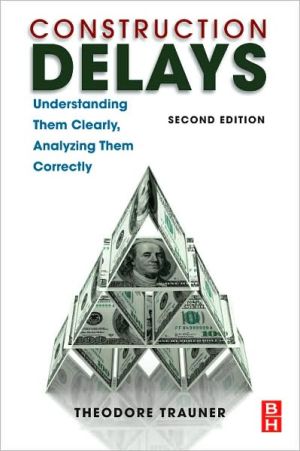Construction Delays: Understanding Them Clearly, Analyzing Them Correctly
Delays in construction projects are frequently expensive, since there is usually a construction loan involved which charges interest, management staff dedicated to the project whose costs are time dependent, and ongoing inflation in wage and material prices. Many techniques are used to analyze delays. Some of these methods have inherent weaknesses and should be avoided. This book points out the shortcomings of these faulty methods and explains how a delay analysis should be performed. It then...
Search in google:
Practical, hands-on-guide to the prevention of construction delays and damages.
Foreword xiAcknowledgments xiiiIntroduction to Second Edition xvChapter 1 Project Scheduling 1The Project Schedule 1The Purpose of a Project Schedule 2Types of Project Schedules 3What Is the Contemporaneous Schedule? 8What Is the Critical Path? 8What Is Float? 10Redefining the Critical Path 11Who Owns Float? 15Reviewing and Approving the As-Planned Project Schedule 16Reviewing and Approving Schedule Updates 21Early Completion Schedules 22Chapter 2 Types of Construction Delays 25What Is a Delay? 25Critical versus Noncritical Delays 25Excusable versus Nonexcusable Delays 27Compensable versus Noncompensable Delays 28Concurrent Delays 31Chapter 3 Measuring Delays-The Basics 37The Importance of Perspective 37Use the Contemporaneous Schedule to Measure Delay 42Do Not Create Schedules after the Fact to Measure Delays 42What to Do When There Is No Schedule 43What Is the As-Planned Schedule? 43What Is As-Built Information? 44The Importance of the Critical Path 45Underlying Principles for Analyzing a Schedule for Delays 46The Unique Position of Subcontractors 50Chapter 4 Delay Analysis Using Bar Chart Schedules 55Defining the Critical Path 56Quantifying Delays Using Bar Chart Schedules 63Chapter 5 Delay Analysis Using CPM Schedules 75Using CPM Schedules to Measure Delays 75Identifying the As-Planned Schedule 76Correcting versus Leaving Errors 76CPM Schedules and the Critical Path 78Identifying Schedule Updates for the Purpose of Measuring Delays 80Use of Scheduling Software and Other Software Tools in the Quantification of Delays 86Chapter 5 Examples 94Chapter 6 DelayAnalysis Using No Schedules 117Use of Contemporaneous Documents for Sequence and Timing 117Using an As-Built Analysis to Quantify Delays 120Chapter 7 Other Analysis Techniques-Their Strengths and Weaknesses 127Using Fragnets to Quantify Delays 128Windows Techniques 138Impacted As-Planned Analyses 142Collapsed As-Built Analyses 154Analyses Based on Dollars 155But for Schedules, Analyses, and Arguments 158Chapter 8 The Owner's Damages Due to Delay 161Liquidated Damages 161Actual Damages 167Chapter 9 The Contractor's Damages Due to Delay 171General Guidelines for the Presentation and Recovery of Damages 171Types of Delay Damages 174Escalation of Labor Costs 176Equipment Costs 181Material Costs 183Other Delay Costs 188Chapter 10 Home Office Overhead 189What Is Home Office Overhead? 189Effects of Delays on Home Office Costs 191Eichleay Formula 192Canadian Method 196Calculation Using Actual Records 197Net Present Value Analysis 198Chapter 11 Inefficiency Caused by Delay 205What Is Inefficiency? 205Ways That Delay Can Lead to Inefficiencies 205Quantifying Inefficiency 209Quantifying the Costs of Inefficiency 210Chapter 12 Acceleration 211What Is Acceleration? 211Why Is a Project Accelerated? 212Constructive Acceleration 213How Is a Project Accelerated? 214Quantifying the Time Savings Associated with Acceleration 215Quantifying the Costs of Acceleration 216Chapter 13 Other Categories of Delay Damages 221Damages Associated with Noncritical Delays 221Consulting and Legal Costs 224Lost Profits/Opportunity Costs 225Chapter 14 Determining Responsibility for Delay 227Contract Requirements 227Gathering the Facts 228Evaluating Responsibility 229Weather Delays 229Chapter 15 Risk Management 233Owner's Considerations 233Construction Manager's Considerations 249General Contractor's Considerations 251Subcontractor's and Supplier's Considerations 253Design Consultant's Considerations 254Real-Time Claims Management 255Index 257








